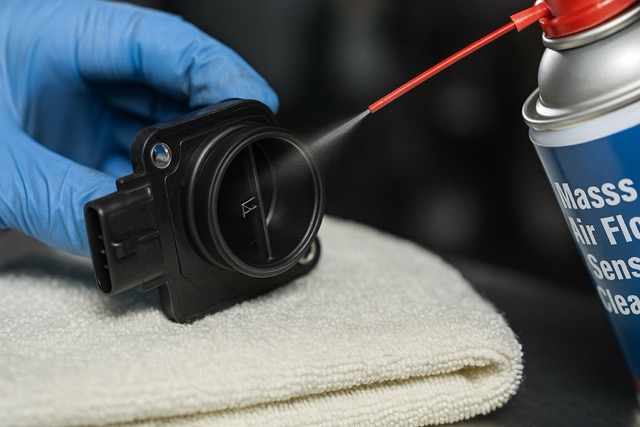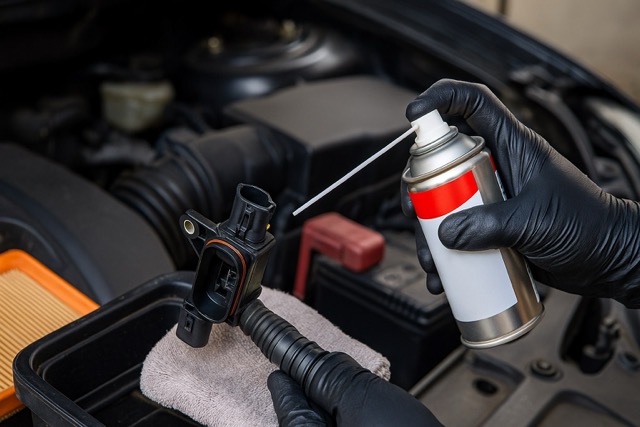How to Clean Mass Air Flow Sensor Step by Step (Beginner’s Guide): Your car’s mass air flow sensor (MAF sensor) might be small, but it plays a huge role in how your engine performs. This component measures the amount of air flowing into the engine so the ECU (engine control unit) can deliver the perfect air-to-fuel ratio. When it’s working properly, your car runs smoothly, accelerates easily, and uses fuel efficiently.
But over time, the MAF sensor collects dust, pollen, grease, and even microscopic oil particles. A dirty sensor sends incorrect readings to the ECU, which can lead to wasted fuel, sluggish acceleration, and even a glowing check engine light. That’s why learning how to clean mass air flow sensor step by step is one of the easiest and most cost-effective ways to keep your vehicle in top shape.
The good news? You don’t need to be a professional mechanic. Even beginners can learn how to clean mass air flow sensor step by step in under 20 minutes with the right tools and a little care. This guide will walk you through exactly what the sensor does, why it matters, the symptoms of a dirty MAF, and the products you’ll need before starting.
Related: Best Mass Air Flow Sensor Cleaner Spray: CRC vs Alternatives
Best Ways of Cleaning Mass Air Flow Sensor for Better Fuel Economy

What is a Mass Air Flow Sensor?
The mass air flow sensor is a key part of your car’s intake system. Located between the air filter and the throttle body, its job is simple but critical: it measures the amount of air entering the engine and sends that data to the ECU. Based on these readings, the ECU adjusts the amount of fuel injected to maintain the perfect combustion balance.
When the sensor is clean, your engine runs efficiently. But when dirt, dust, or oil buildup coats the sensor’s delicate wires, the readings become inaccurate. That’s when you start to notice problems.
Some of the most common mass air flow sensor symptoms when it’s dirty include:
- Rough idle or engine vibration when stopped.
- Poor fuel economy (more trips to the gas station than usual).
- Hesitation or jerking when accelerating.
- Check engine light triggered by airflow-related codes.
- In severe cases, stalling or difficulty starting the engine.
The good news? These symptoms often disappear after a proper cleaning. That’s why cleaning mass air flow sensor is considered preventive maintenance, not just a fix when problems occur.
Tools and Products You’ll Need
Before you begin learning how to clean MAF sensor step by step, it’s important to gather the right tools. Using the correct products ensures you won’t damage the delicate sensor wires during cleaning.
Here’s what you’ll need:
- Mass air flow sensor cleaner spray → A dedicated spray designed for sensors, such as CRC mass air flow sensor cleaner, is the safest choice. It’s residue-free, fast-drying, and won’t damage sensitive electronics.
- Screwdriver or socket set → To loosen clamps or screws holding the sensor in place.
- Gloves and safety glasses → For personal protection when handling cleaners.
- Soft towel or cloth → To place the sensor on while it dries.
- Optional: OBD-II scanner → Useful for testing mass air flow sensor after cleaning to confirm it’s working correctly.
Tip: Never substitute the cleaner with harsh chemicals like carburetor or brake cleaners. They can corrode the sensor and ruin it permanently. A can of proper maf sensor cleaner costs less than $15, while replacing the sensor can cost several hundred dollars.
Mistakes to Avoid
Before you begin, it’s important to understand the risks. The mass air flow sensor is delicate, and one wrong move could mean replacing it instead of cleaning it. Here are the key mistakes to avoid:
- Never touch the delicate wires inside the sensor. The tiny platinum wires are extremely fragile. If they break or bend, the sensor will stop working, and no amount of cleaning will fix it.
- Avoid using the wrong chemicals. Some DIYers try cleaning maf sensor with brake cleaner or cleaning maf sensor with carb cleaner, but both are too harsh. They can strip protective coatings, corrode sensitive parts, and leave behind residues. Always use a dedicated mass air flow sensor cleaner spray or maf cleaner.
- Don’t rush drying. After spraying, allow the sensor to air dry fully for at least 15 to 20 minutes. If you reinstall it while wet, it can short out and trigger error codes.
- Know the difference between cleaners. Many people confuse MAF cleaner with CRC throttle body cleaner, but they are not the same. While CRC throttle body cleaner is safe for removing carbon deposits in the throttle body, it is too strong for the fragile MAF sensor. Stick with CRC mass air flow sensor cleaner for best results.
By avoiding these mistakes, your cleaning maf sensor routine will be safe, effective, and long-lasting.
Step-by-Step Guide: How to Clean Mass Air Flow Sensor
Now that you know what to avoid, let’s go through the exact process of how to clean mass air flow sensor step by step. Even beginners can follow this guide with basic tools and a little patience.
Step 1: Locate the Sensor
The first step is finding the sensor itself. The typical MAF sensor location is between the air filter housing and the throttle body. It’s a small plastic device connected by a wiring harness, usually secured with clamps or screws.
If you’re not sure, consult your owner’s manual for diagrams.
Step 2: Disconnect the Battery & Harness
Safety first. Turn off the engine and disconnect the negative battery cable. This prevents accidental short circuits.
Next, unplug the wiring harness from the sensor. Be gentle; forcing it can damage the connectors.
Step 3: Remove the Sensor
Using a screwdriver or socket set, loosen the clamps or screws holding the sensor in place. Carefully slide the sensor out of its housing.
Important: Do not touch the internal sensing wires; they are extremely sensitive.
Step 4: Apply Cleaner
Now it’s time to spray. Take your mass air flow sensor cleaner spray (CRC is highly recommended) and apply 10 to 15 quick bursts directly into the housing and onto the sensing element.
- Hold the sensor upright for even coverage.
- Never wipe with a cloth or cotton swab, this can leave fibers or break the wires.
- Never blow with compressed air, as the force can shatter the element.
The goal is a gentle, residue-free clean. That’s why a proper MAF sensor cleaner is essential.
Step 5: Let It Dry
Place the sensor on a soft towel in a clean area. Allow it to air dry completely for at least 15–20 minutes.
Don’t use a heat gun or hair dryer; excessive heat can damage the electronics.
Once it’s dry, reinstall the sensor, reconnect the wiring harness, and reattach the battery. Your car should now idle smoothly, accelerate more cleanly, and deliver better fuel economy.
Step 6: Reinstall the Sensor
Once the sensor is fully dry, it’s time to put it back. Carefully slide the mass air flow sensor back into its housing and secure it with screws or clamps. Make sure it’s snug, but don’t overtighten; you don’t want to crack the plastic.
Next, reattach the wiring harness by plugging it back into the connector until you hear or feel a click. Finally, reconnect the negative battery connection you removed earlier.
With everything back in place, your clean MAF sensor is ready to go.
Step 7: Test the Car
Start your engine and let it idle for a few minutes. A properly clean mass air flow sensor should give you smoother idling, quicker throttle response, and fewer stalls.
If you have an OBD-II scanner, you can go a step further by testing mass air flow sensor readings directly. Look at the airflow data (measured in grams per second). A freshly cleaned sensor will show values that rise and fall smoothly as you rev the engine.
If the engine runs noticeably better and the check engine light disappears, you’ve successfully completed the job.

How Often Should You Clean the MAF Sensor?
The best schedule for cleaning mass air flow sensor is typically every 12,000–20,000 miles, or whenever you replace your air filter. Since the filter and sensor work together, maintaining both ensures clean airflow and accurate readings.
If you live in dusty or sandy environments, you may need to perform cleaning the mass airflow sensor more frequently. Off-road drivers and city commuters in polluted areas often benefit from cleaning every 10,000 miles.
Pro tip: Add cleaning maf sensor to your regular maintenance checklist along with oil changes and air filter replacements. This preventive step keeps your car running at peak efficiency.
Does Cleaning MAF Sensor Work? (Real Results)
One of the most common questions is: does cleaning MAF sensor work? The answer is a strong yes.
Case studies and mechanic testimonials consistently show that performing a simple cleaning mass air flow sensorroutine restores lost performance. Drivers often report:
- Immediate improvement in fuel economy (3% to 10% better MPG).
- Elimination of rough idle or stalling issues.
- Smoother acceleration.
- Disappearance of check engine light codes related to airflow.
For example, one driver noted that after they decided to clean maf sensor, their car stopped stalling at stoplights and fuel efficiency returned to normal. Another mechanic shared that 7 out of 10 cars brought in with “bad MAF” codes only needed a proper cleaning, not a replacement.
So yes, does cleaning MAF sensor work? Absolutely — it’s one of the cheapest and most effective DIY maintenance tasks you can do.
When to Replace Instead of Clean
While cleaning the MAF sensor is effective most of the time, there are situations where replacement is the only solution.
You should replace your sensor if:
- Your clean MAF sensor still shows the same mass air flow sensor symptoms (rough idle, poor MPG, hesitation).
- The sensor is cracked, corroded, or physically damaged.
- Cleaning doesn’t restore proper airflow readings during testing mass air flow sensor with a scanner.
- The car continues to misfire or stall despite cleaning.
In these cases, no cleaner will save the unit. A new mass air flow sensor is the only fix. Fortunately, by trying cleaning first, you often avoid unnecessary replacement and save hundreds of dollars.
FAQs
How to clean MAF sensor without cleaner?
If you don’t have dedicated spray, you might wonder how to clean MAF sensor without cleaner. The safest DIY option is using high-purity isopropyl alcohol (90%+). Place the sensor on a towel, lightly spray or mist the alcohol onto the element, and let it fully air dry for 20–30 minutes. This can work in an emergency, but it’s not as effective or safe as a proper mass air flow sensor cleaner spray.
How to clean MAF sensor with alcohol?
Many drivers ask how to clean MAF sensor with alcohol. While isopropyl alcohol can dissolve dust and oil, it’s riskier because it may leave residues if it’s not pure. If you try this, never use a cloth or swab, only mist spray, and allow plenty of drying time. Whenever possible, use a professional maf sensor cleaner like CRC mass air flow sensor cleaner for the best results.
What’s the average maf sensor cleaner price?
The maf sensor cleaner price is very affordable compared to replacing the sensor. Expect to pay:
- $8–$12 at AutoZone (U.S.).
- £7–£10 at Halfords (UK).
- $7–$15 on Amazon (often with multi-packs available).
Considering a replacement sensor can cost $150–$400, buying a can of mass air flow cleaner is one of the best investments you can make.
Is cleaning maf sensor with brake cleaner safe?
No. Cleaning maf sensor with brake cleaner is not recommended. Brake cleaner is too harsh for the delicate platinum wires inside the sensor. It can strip coatings, corrode parts, and permanently ruin the unit. Always use a residue-free mass air flow sensor cleaner spray or maf cleaner instead.
Conclusion
Learning how to clean mass air flow sensor step by step is one of the easiest, most beginner-friendly maintenance tasks you can do. In less than 20 minutes, you can restore lost performance, improve fuel economy, and avoid unnecessary repairs.
Always remember:
- Use the proper mass air flow sensor cleaner spray (such as CRC mass air flow sensor cleaner).
- Never use carb cleaner, brake cleaner, or other harsh chemicals.
- Let the sensor dry fully before reinstalling.
A clean MAF sensor can make a huge difference in how smoothly your engine runs and how much fuel you save.
Want to dive deeper? Check out our full detailed guide on mass air flow sensor cleaning, plus related cluster articles like:
- How to Clean MAF Sensor Without Cleaner
- MAF Sensor Symptoms You Shouldn’t Ignore
- Best Mass Air Flow Sensor Cleaner Spray Compared
With the right knowledge and tools, you’ll never look at your car’s performance the same way again.
Related:
- 2 Ways on How to Clean Oxygen Sensor Without Removing It
- What Happens When The Idle Air Control Valve Goes Bad (IAC Symptoms)
- 8 Early Signs of Transmission Problems, causes, and fixes.
- Cost To Replace And Quick Fix For Stolen Catalytic Converter?
- Guide Cost To Replace Serpentine Belt Tensioner For A Few Cars Brands?
